
Where precision meets economic efficiency
NanoOne is the fastest high-resolution 3D printing system on the market. It is based on multiphoton lithography and combines the precision of 2-photon polymerization with an unmatched throughput of up to 200 mm³ per hour. This makes the system suitable not only for scientific research approaches and multi-user facilities but also for the batch and small series production of industrially applied microparts.
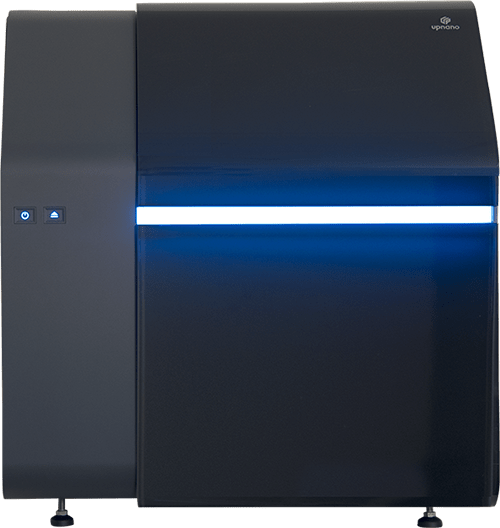
High-resolution 3D printer based on a galvanometer scanner
Fabrication of polymeric parts from micro to mesoscale
Minimal horizontal feature size ≥170 nm
Scanning speed ≥1000 mm/s
Adaptive resolution
High-resolution bioprinting in the presence of living cells

Powerful versatility …
Minimal horizontal feature size ≥170 nm • minimal vertical feature size ≥550 nm • minimal surface roughness ≤10 nm • throughput up to 200 mm³/h • writing speed ≥1000 mm/s • accessible writing area 100x120 mm • part height up to 40 mm • printing with living cells • batch and small series production • desktop system • based on a galvanometer scanner

… for an unlimited range of applications
Electronics
Microoptics
Micromechanics
Microfluidics
Medical engineering
Cell and tissue
Surface elements
Microneedles
Filter elements
Small
High-resolution desktop printing system with sub-micrometer resolution
With up to 1 W, the laser source of the NanoOne system is very powerful, enabling the use of low magnification objectives and thus the production of mesoscale parts. Despite the high power, the laser wavelength has low absorption in cells and enables cell, tissue and bioprinting approaches.
Fast
Up to a 100 times higher throughput for economically relevant production cycles
The patented printing process of UpNano combines highest resolution with unmatched performance for the first time. Scan speeds of ≥1000 mm/s and throughput rates of up to 200 mm³/h enable prototyping as well as batch and series production.
Powerful
High power laser for mesoscale fabrication and biological applications
With up to 1 W, the laser source of the NanoOne system is very powerful, enabling the use of low magnification objectives and thus the production of mesoscale parts. Despite the high power, the laser wavelength has low absorption in cells and enables cell, tissue and bioprinting approaches.
Special modules for bio and high-volume applications
XXX Lorem ipsum dolor sit amet, consectetuer adipiscing elit. Aenean commodo ligula eget dolor. Aenean massa. Cum sociis natoque penatibus et magnis dis parturient montes, nascetur ridiculus mus.
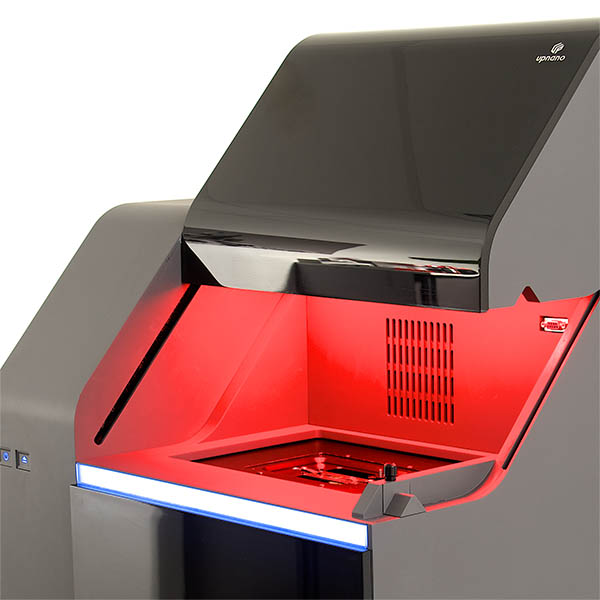
Bio module: xxx lorem ipsum dolor sit amet
Aenean massa. Cum sociis natoque penatibus et magnis dis parturient montes, nascetur ridiculus mus. Donec quam felis, ultricies nec, pellentesque eu, pretium quis, sem. Nulla consequat massa quis enim. Donec pede justo, fringilla vel, aliquet nec, vulputate eget, arcu.

Biocompatible 3D printing in the presence of living cells
Our printing process and biocompatible materials are designed with biofabrication in mind. Living cells can be mixed into the resin and printed directly or seeded on prefabricated structures.
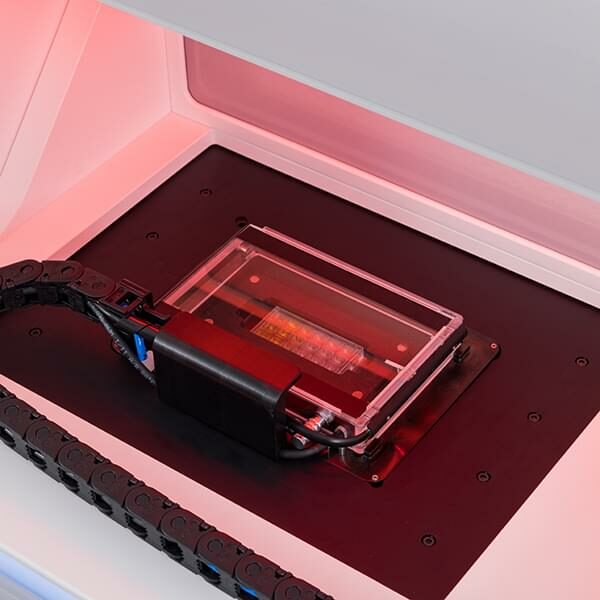
Stage top incubation system
The incubation system with its specifically designed insert can be simply clicked into the building platform. Necessary tubings and cables can be accessed by an interchangeable opening in the door. The incubation system’s temperature control unit makes it possible to adjust humidity and CO2 content to meet the requirements of the cell type used, ensuring a native environment during the print process and thus cell viability.
UpBio: gelatine-based hydrogel material for biocompatible applications and bioprinting
Wide variety of substrates: xxx substrate
Wide variety of substrates: xxx substrate
High-resolution bioprinting
The NanoOne printing system enables direct printing of living cells.
Cells embedded in an UpBio matrix can be used for three-dimensional in-vitro cell tests, which have become increasingly important in cell culture, tissue regeneration and pharmaceutical research. There is hardly any restriction in the choice of substrate. Cell culture plates, Petri dishes or microfluidic chips with glass bottoms can be inserted into the machine with the help of the universal holder. In combination with the stage top incubation system, native temperature, humidity and CO2 conditions are controlled during the printing process, ensuring cell variability.


Biocompatible structures
Fabrication of structures and surface textures mimicking the microenvironment of cells
UpNano’s materials allow the fabrication of structures and surface textures mimicking the microenvironment of cells. These three-dimensional culture approaches, and especially the results obtained from them, are becoming increasingly important in preclinical research and will be groundbreaking for future therapeutic strategies.
Microfluidic applications
Fabrication of high-resolution structures directly within a microfluidic chip
Internal elements such as separators, channels or membranes can be fabricated directly within a commercially available or custom-made microfluidic chip. The printing process takes place under sterile conditions. The material is prepared and injected under the laminar hood and the sealed chip can then be placed in the printing system and postprocessed in a sterile environment.

High volume module: high-speed 2PP printing
The NanoOne printing system once and for all puts an end to the thinking that "2PP printing is meant to be slow”. The innovative and patented printing process makes it possible not only to produce microcomponents with the usual high resolution and structural details in the range of 170 nm, but also to take the step towards batch and series production.
Within one print job, the NanoOne system can print a series of components that are either identical or differ in design and/or printing parameters. With just a few clicks, the desired parameters can be assigned to the components. Alternatively, the predefined and proven print profiles can be used.
The enormous performance of the system also makes it possible for the first time to produce components in the centimeter range. With a possible component height of up to 42 mm, the NanoOne system closes the gap between conventional 2PP printing systems and microstereolithography. And it does so with extraordinary speed.

Great ideas need to have room
No matter whether large-volume components with an edge length in the centimeter range or the first small series. The high volume package enables the implementation of project ideas that previously seemed impossible.
Larger material vats and suitable substrates with an edge length of 20x20 mm or wafers with a 1" diameter offer the greatest possible design freedom and take the first step towards industrial implementation. With this setup, for the first time ever, series production of 2PP manufactured microcomponents is possible while at the same time user interaction is reduced to a minimum.
The powerful laser that can be built into the NanoOne system allows the use of low magnification objectives and thus the production of unexpectedly large structures with structure details of less than 2 microns. The solution for components in the sweet spot between classic 2PP and microstereolithography applications.
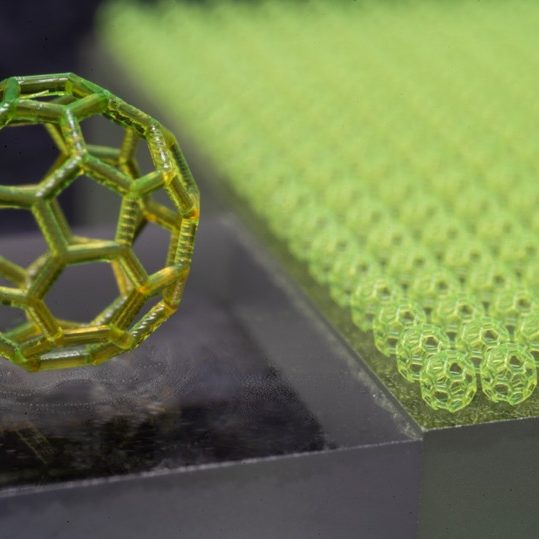
Clean even without a clean room
In the production of micro and nanoscale, a clean working environment with a low level of particles is an absolute must. That's why the NanoOne printing systems are equipped with an H14 HEPA filter by default.
When loading and unloading the NanoOne system, clean room class ISO7 can be maintained. In the closed state, during the printing process, no particles >0.3 micrometers are detectable. This means that low-contamination loading and unloading and contamination-free printing is possible even without a clean room.
XXX Bildbeschreibung
XXX Bildbeschreibung
XXX Bildbeschreibung
XXX Bildbeschreibung
XXX Bildbeschreibung
XXX Bildbeschreibung
Perfect materials for demanding applications
UpNano’s high performance 2-photon materials are optimized to utilize the full potential of the ultrafast high-resolution NanoOne printing system. UpNano offers photopolymers and hybrid materials, in addition to hydrogel materials for biological applicationsol-gels.
We are open – when it comes to material
In addition to the materials offered, commercially available resins and established 2PP printing materials can be used with the printing system. The UpNano material experts are happy to assist in the selection of materials or the development of customer-specific materials.

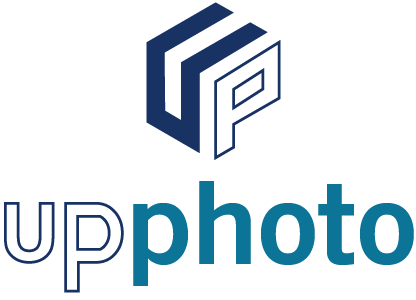 |
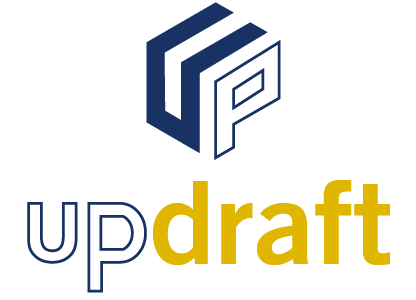 |
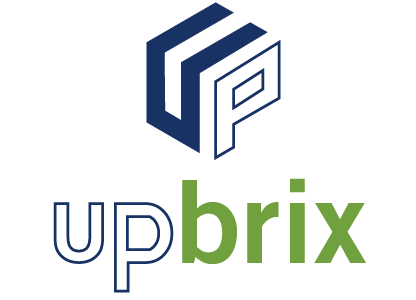 |
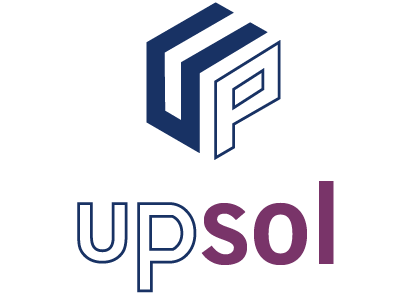 |
|
|---|---|---|---|---|
| Common objective | 4x/10x/20x | 10x/20x | 60x | 60x/20x/10x |
| Fabrication speed | ++ | +++ | ++ | ++ |
| Vat mode | ■ | ■ | ■ | |
| High volume – large scale | ■ | ■ | ||
| High aspect ratio | ■ | ■ | ■ | |
| Low viscosity | ■ | ■ | ||
| Refractive index matched | ■ | |||
| 2.5D structures | ■ | ■ | ||
| Sub-micrometer printing | ■ | ■ | ||
| >90° overhang without support | ■ |
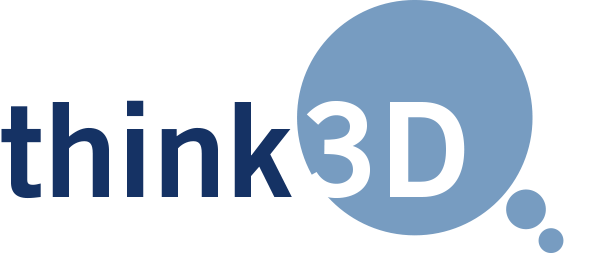
One printer, one software
Whether predefined basic structures or customized CAD objects, NanoOne is the system of choice for a broad range of high-resolution applications. The intuitive THINK3D user software supports the customer throughout the entire printing process.
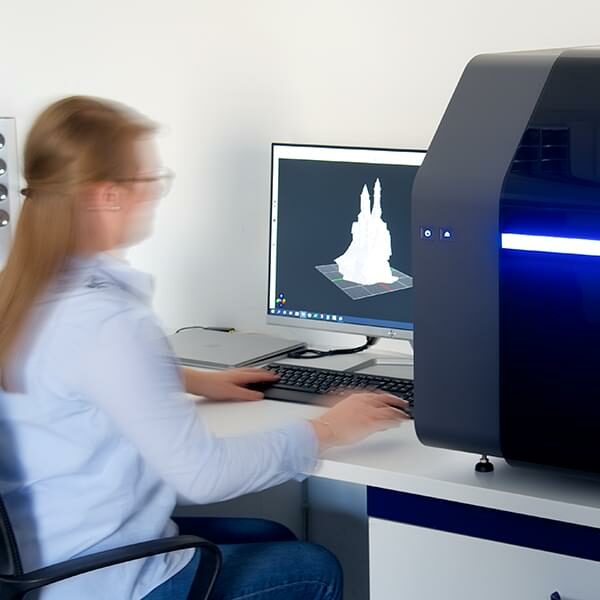

One-stop shop for holistic solutions
In addition to UpNano’s ultrafast high-resolution 3D printing system NanoOne, we offer products and services related to the additive manufacturing of microparts. This way we do not only sell individual products but holistic solutions.

NanoOneⓇ
3D printing system

think 3D
software application

Full-range
accessories

Long-term
support
Small
High-resolution desktop printing system with sub-micrometer resolution
Not only are the achievable structural details of ≥170 nm small, also the printing system itself is small. With external dimensions of 58.5 x 71 x 65 cm³, the NanoOne fits not only into industrial production halls but also intothe narrowest lab.
Fast
Up to 100 times higher throughput for economical relevant production cycles.
The patented printing process of UpNano combines highest resolution with unmatched performance for the first time. Scan speeds of up to 600 mm/s and throughput rates of up to 200 mm³/h enable prototyping as well as batch and serial production.
Powerful
High power laser for mesoscale fabrication and biological applications
With up to 1 W of power, the laser source of the NanoOne is very powerful, enabling the use of low magnification objectives and thus the production of mesoscale parts. Despite the high power, the laser is gentle to cells and enables cell, tissue and bioprinting approaches.

Perfect materials for demanding applications
NanoOne is the fastest high-resolution 3D printing system on the market. It is based on multiphoton lithography and combines the precision of 2-photon polymerization with unmatched throughput.
One printer, one software
Whether predefined basic structures or customized CAD objects, NanoOne is the system of choice for a broad range of high-resolution applications. The intuitive THINK3D user software supports the customer throughout the entire printing process.
Features
- Intuitive handling of the NanoOne printing system
- Print job files including all parameter settings
- Predefined print profiles for optimal results
- Series production of identical or different objects
- 3D preview of the created print job
- Real-time processing of data without preprocessing
- Advanced logging feature including user accounts
- Adaptive resolution for highest resolution where needed
- Integrated, automated monitoring of machine

Import of CAD objects
created with a design program of choice

print profiles & customized parameters
Part size, part alignment and positioning, laser power, energy distribution, write speed, stitching, overlap, outline modus

Get more out of your print job
Arrays, Parametric objects, channelled elements, gyroids

In focus!
Fluorescence-based autofocus system

